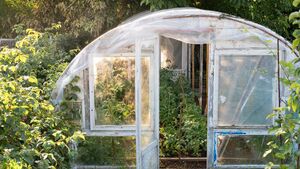Living Greener: Greenhouses are a worthwhile investment

Greenhouses remain a worthwhile investment for gardeners in most climates, albeit an expensive one
WHEN people list history’s most world-changing inventions, they usually include fire, or guns, or computers.
Rarely do people mention something so ubiquitous to us that it has become, literally, invisible – glass and transparent plastic. Glass was known to the ancients but was rare — the Book of Job lists it with gold among the most precious of materials.
In the Renaissance, though, when glass began to be sheeted and shaped in quantity and with skill, it created a boom in civilisation; microscopes and telescopes opened up the breadth of the world to science, spectacles doubled men’s intellectual years, and windows allowed for the creation of the first greenhouses.
We spend so much technology and energy — electricity, oil and coal — to heat homes against the weather, altering it to suit our needs. Properly-placed windows, however, allow the sun to do our work for us, allowing light in and slowing the passage of heat out.
Even when the temperature outside dips below freezing, they keep out frost, with the added benefit of allowing the gardener to more easily control water, pests and wind-blown seeds.
Nowhere, perhaps, is this more important than in a land like this, a nearly subarctic island kept mild by the Atlantic current. Here, greenhouses extend the growing season by months and create pockets of Italy or Illinois in, say, the cold bogs of Co Kildare.
Here and in Britain, greenhouses, cloches and coldframes allowed Victorian master gardeners to grow a range of seemingly impossible crops: not just tomatoes and aubergines but melons, lemons, limes, grapes, olives and peaches.
Pineapples, for example, became a status symbol among the manor-born, and banquets sported them as a centrepiece.
Greenhouses remain a worthwhile investment for gardeners in most climates, albeit an expensive one. If you want to start small, though, you can create cloches, transparent coverings for one or a few plants each.
Victorians, again, mass-produced glass bells to cover plants to create a microclimate inside. You can do the same thing, however, with soda bottles.
To make a cloche, cut the bottom off an old soda bottle – the two-litre kind – and place it around a seedling in the garden. Once the bottom is off, the plastic becomes very flimsy, so you might want to bury the edges several centimetres deep to keep it stable.
Alternatively, you can place a ring or solid structure inside if you have one, something that will keep the bottle in place but allow the seedling to grow. Or you can place it around a flowerpot whose diameter is smaller than that of the bottle.
Cloches, like greenhouses, allow you to regulate the amount of water a plant receives – here that means not getting waterlogged in the rainy winter. You might want to keep the caps of your soda bottles in a drawer, so you can put them back on at night if it gets too cold.
A step up from a cloche is a row cover, something to put over an entire bed. We clamped flexible plastic piping over our raised beds to make hoops, draped clear plastic over them and secured the plastic to the wood below the hoops with staples.
Alternatively, instead of plastic, you could put horticultural fleece over another raised bed, to keep the warmth in. We did both this year, and gave our plants such protection that our corn salad survived the month of snow and ice.
If you want to go sturdier still, you can build a coldframe, especially if you have old windows you can use. A coldframe is just a box with glass or transparent plastic on top, ideally with a top slanted toward the south.
Fill the box with earth and plant seeds inside, and over the slanted top secure a sheet of glass or whatever you have. You could install the window frame with hinges at the top for maximum convenience, but taking off the glass gently will do.
Polytunnels are an excellent means of creating a walk-in garden for a fraction of the cost of an old-style greenhouse. You can get one as small as a closet or as large as a house, and most are guaranteed for a decade or two.
With the help of a little store-bought or scavenged material, you can create a patch of warmer climate right where you live.






